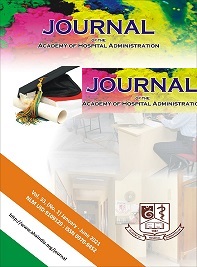TURNAROUND STRATEGIES IN HOSPITAL INFECTION CONTROL AND BIOMEDICAL WASTE MANAGEMENT
DrPavithra LS*, Dr Amitha**, DrSomu G***
Abstract:
Introduction: OT linen includes surgical gown, lap bundle, drape bundle, trolley drape and other packages for each surgery. Usage of reusable OT linen in OT is prevalent in majority of Indian hospitals.Recently, usage of disposable OT linen is rampant in most of the private hospitals. It has a higher advantage of reduced infection transfer to the patient and to the handlers as well. Disposable gowns are used only once and are good in providing protection; however, the problems associated with disposable fabrics are high-risk contamination, environmental issues through waste and landfill, expense, and discomfort if they are reinforced with a plastic film.1Reusable linen are usually more comfortable than disposable fabrics; however, reusable cotton fabric without a finish does not protect against bacterial penetration.2 Aim & Objective: This study aims to bring to light the strategies adopted in healthcare practice for improving the hospital acquired infection (HAI) rates and managing biomedical waste. The objectives was to study the change in hospital infection control rates by adopting innovative practices likedisposable linen as against recycling of hospital linen. The study also gives us a picture on the evolving waste management practices in healthcare all aimed at optimizing the hospital infection rate.Material &Methods: The study is retrospective with data collection over two time frames, (i.e.2009-10 and 2014-15) and involved data collection related to surgical site infection; volume of waste generated in using disposable gowns; tracking of Hospital infection and observation of changing practices. Chi Square test was applied to ascertain the statistical significance. Results & Conclusion: The study showed that the total number of surgical cases was about 22562 when using reusable linen and surgical site infection (SSI) during the period was 98. The total number of surgical cases done using disposable linen (2014-15) was 28571 with a total SSI of 78.Chi square test used to ascertain the significance showed p-value as 0.0019 (test of significance at p<0.05) which is highly significant. Biomedical waste generated was outsourced during the years 2009 onwards with the hospital paying based on number of kilograms of waste generated. However over the years the same has been abolished and the terms of payment have been fixed on the bed complement irrespective of the quantity of waste generated. Hence an increase in the volume of waste generated did not have any cost impact on the biomedical waste. The study brings to light that in switching over to disposable linen, there is a reduction (from 0.43% to 0.27%) inhospital acquired infection rate. Hence switching over to disposal gowns may be considered as a contributory factor towards control of Hospital acquired infection (HAI).
Key Words: Hospital Infection control (HIC); surgical site infection (SSI); Linen; Biomedical Waste management; Hospital Acquired Infection (HAI)






